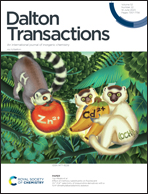A water stable and highly fluorescent Zn(ii) based metal–organic framework for fast detection of Hg2+, CrVI, and antibiotics†
Abstract
The development of luminescent metal–organic frameworks for effective sensing and monitoring of environmental pollutants is of great significance for human health and environmental protection. In this work, a novel water-stable ZnII-based luminescent coordination polymer, namely {[Zn(BBDF)(ATP)]·2DMF·3H2O}n ((BBDF = 2,7-bis(1H-benzimidazol-1-yl)-9,9-dimethyl-9H-fluorene) and H2ATP = 2-aminoterephthalic acid), was designed and obtained using the mixed-ligand method. Structural analysis indicated that 1 presents a two-fold interpenetrated two-dimensional layer structure with one dimensional (1D) channels along the a axis. Intriguingly, the uncoordinated –NH2 group was danged onto the pore walls of 1. Remarkably, compound 1 shows good aqueous stability at different pH values of 3–13 and exhibits a fluorescence turn-off sensing behavior for Hg2+, Cr2O72−, CrO42−, and antibiotics (NFZ, NFT) in aqueous solution with high selectivity and sensitivity. The limits of detection (LOD) are 0.12 μM (Hg2+), 0.17 μM (Cr2O72−), 0.21 μM (CrO42−), 0.098 μM (NFZ), and 0.14 μM (NFT). The luminescence quenching mechanism analysis by experiment and theoretical calculation revealed that the competitive absorption and the photoinduced electron transfer process are largely responsible for the sensing of the two antibiotics, while the weak interaction contributes to the selective luminescence quenching for Hg2+.



 Please wait while we load your content...
Please wait while we load your content...